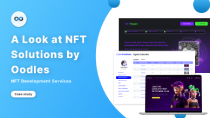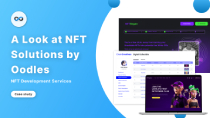Blockchain - NFT Development
Elevate your business with our NFT Development Services! From custom marketplaces to token creation, we deliver secure, scalable, and innovative NFT solutions. Empower your brand with cutting-edge blockchain tech and unlock new revenue streams. Let's build your NFT success story today!
Elevate your business with our NFT Development Services! From custom marketplaces to token creation, we deliver secure, scalable, and innovative NFT solutions. Empower your brand with cutting-edge blockchain tech and unlock new revenue streams. Let's build your NFT success story today!
View More
Related Area Of Works
Transformative Projects
View All
Anime Metaverse (AM) is a blockchain-based publishing and licensing company focused on developing anime and manga IPs as blockchain assets in the web3 environment. They approached Oodles Platform to upgrade the arts and metadata of Supernova. The project involved three phases: enhancing backgrounds, revamping Rikka, and updating common characters to provide an immersive and visually stunning experience for anime enthusiasts.
Technologies Involved
Area Of Work

Moments, renowned for launching the world’s first multiverse NFT sought to expand into the NFT space with poker heroes. Moments approached Oodles to develop an NFT auction marketplace for this new venture. The project involved creating a secure crypto wallet login system, an avatar minting system, an Admin Dashboard, a Casino-Lobby, a Cashier module, and in-app promotional features to enhance user engagement and marketplace functionality.
Technologies Involved
Area Of Work

CRD Coin is an innovative organization transforming how educational institutions issue and manage certificates and degrees. CRD Coin approached Oodles Platform to develop a cutting-edge backend system. The solution featured three panels: Main Application, Admin Panel, and Institution Panel. The Admin Panel allowed for managing admins, school registrations, and revenue transactions, while the Institution Panel supported certificate uploads.
Technologies Involved
Area Of Work

DISTINCT is a media distribution and technology platform that offers a new destination for content owners, brands, consumers, and original creators. DISTINT approached Oodles Platform for a blockchain-centered network solution to transcend traditional media and commerce platforms. In response, the project provided a comprehensive ecosystem to cultivate premium content and experiences, binding communities together.
Technologies Involved
Area Of Work

Sosh is a Web3 social media platform focused on content monetization. It enables content creators to license commercial rights to their content via non-fungible tokens (NFTs) and receive payments in tokens. The client approached Oodles for a robust platform with seamless crypto wallet integration for login and adherence to the WalletConnect protocol. Oodles developed a user-centric digital ecosystem.
Top Blog Posts
 Mudit Kumar
Mudit Kumar
 Rahul Maurya
Rahul Maurya
 Mudit Kumar
Mudit Kumar
 Mudit Kumar
Mudit Kumar
 Dimple Dasila
Dimple Dasila
Core Technologies
Additional Search Terms
Industries we have served
































